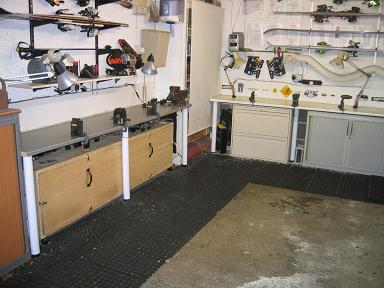 Whilst something like a Black & Decker Workmate is fine for use as an occasional tuning bench, if you’re going to be tuning skis regularly it’s worth building your own bench in the garage or shed etc. Racers will find the proprietary folding benches useful as they can take them to events for between race touch-up’s.
Whilst something like a Black & Decker Workmate is fine for use as an occasional tuning bench, if you’re going to be tuning skis regularly it’s worth building your own bench in the garage or shed etc. Racers will find the proprietary folding benches useful as they can take them to events for between race touch-up’s.
If you make your own bench here's a few things that you might find helpful:
It's important to get the bench height right. The engineering rule of thumb for heavy work (& scraping is heavy work) is for the workpiece (ie the ski or board) to be about 4" below your elbow height when standing upright. Don't forget to allow for the height of your vice when calculating your bench height. Your back will thank you for getting this right.
Position the plug socket for your iron in a place were the flex won't get snagged. A laminate worktop makes it easier to remove blobs of wax & metal shavings. Putting your tools on a wall mounted peg board looks impressive but if you're garage is actually going to house a car it can get pretty dusty so it's probably better to put them in a cupboard underneath. Sliding doors are best so the open doors don't trip you up.
If you do a lot of tuning it's handy to have two benches so you can be doing both edge work & base work at the same time. 50-60cm deep worktops allow the tools in use to be at the back away from any filings or wax scrapings etc. The bench only needs to be wide (ie left to right) enough to support the two end vices in the correct position although the benefit of having worktop under the full length of the ski means that most of the filings/wax scrapings will fall on the bench rather than the floor, making them easier to clean up. The most important thing is that the bench is stable as a number of process require significant pressure so it's best to have the bench fixed to the wall.
For lighting I've a 1500/1800mm flourescent tube directly the works well plus two angle poise lights, one at each end of the bench, each fitted with 60w wide angle bulbs. These are set below eye line to illuminate the skis evenly without dazzling when working. Many workshops use wall mounted lighting to minimise shadow. The problem is that when scraping the skis you really do have to lean over them so anything wall mounted has to be set really low which tends to dazzle. This is were the angle poise lamps work well as you can alter their position to give the best illumination for the particular process you're doing.
A fan heater is useful as it can get chilly in the winter. If you're tuning through the summer for Xscape or dry slope use then one that also blows cold is useful. A rubber mat or similar on the will also stop your feet from freezing in the winter as well as having great anti-fatigue properties if your tuning multiple skis/boards in one session.
If you plan on doing a lot of tuning, especially with high fluorocarbon race waxes, it's worth fitting an extract fan as breathing wax fumes & dust can't be that good for you - & you won't want the garage or shed door open for ventilation in the winter.
It's best to put your ski or board rack on the wall above the bench to make it easier/faster/safer to swap them over. It’s simply made from that wall fixed slotted aluminium shelving bracket stuff from B&Q. The skis sit horizontally on the shelf brackets with their bindings facing down. From here they can be easily lifted to/from the bench. It's an ideal place to leave the freshly waxed skis to cool before scraping - skis propped up against the wall have a tendancy of falling over! I've glued a strip of rubber on the top of the shelf brackets so the top sheets of the skis don't get scratched.
And don't foget the music & beer!
And don't foget the music & beer!
